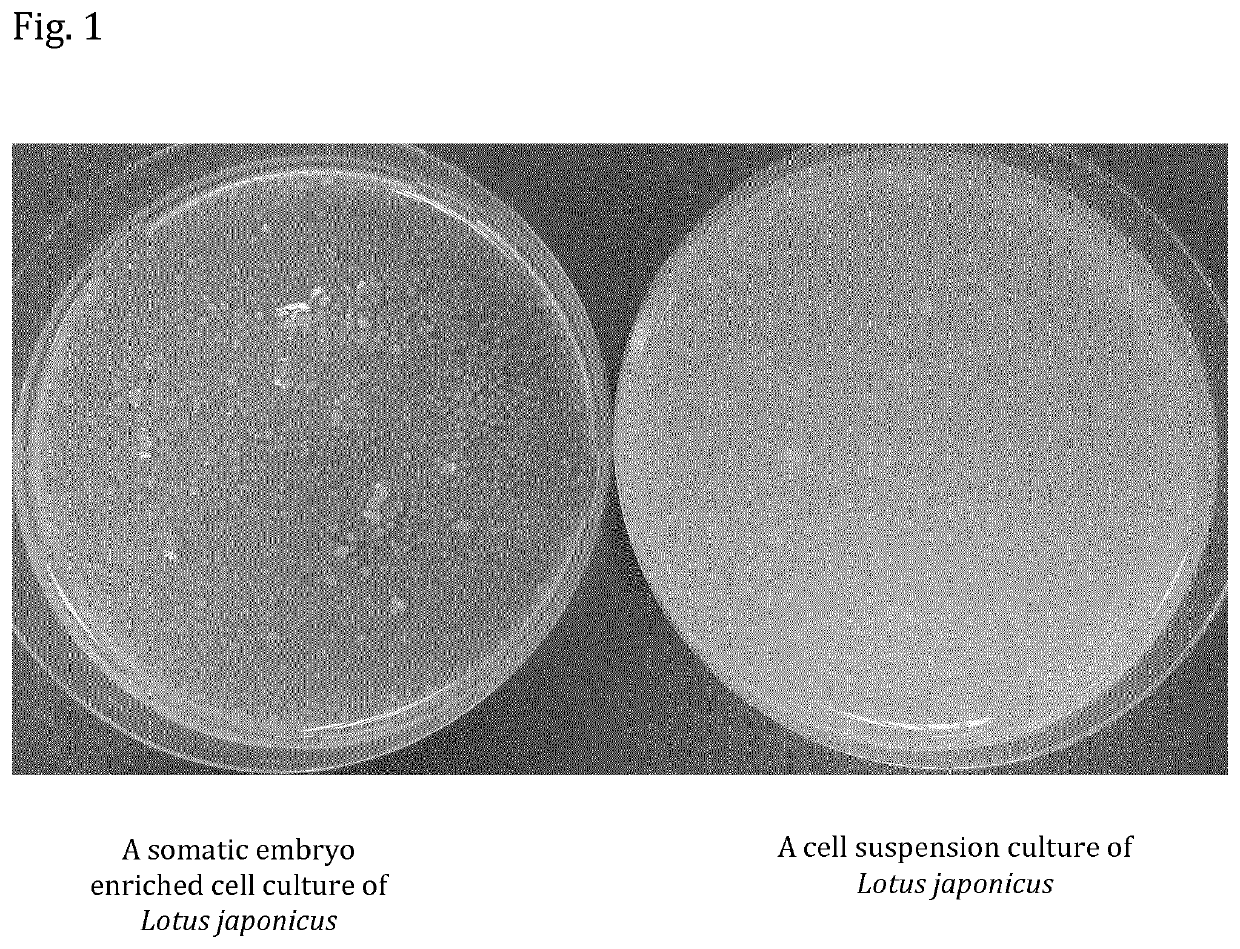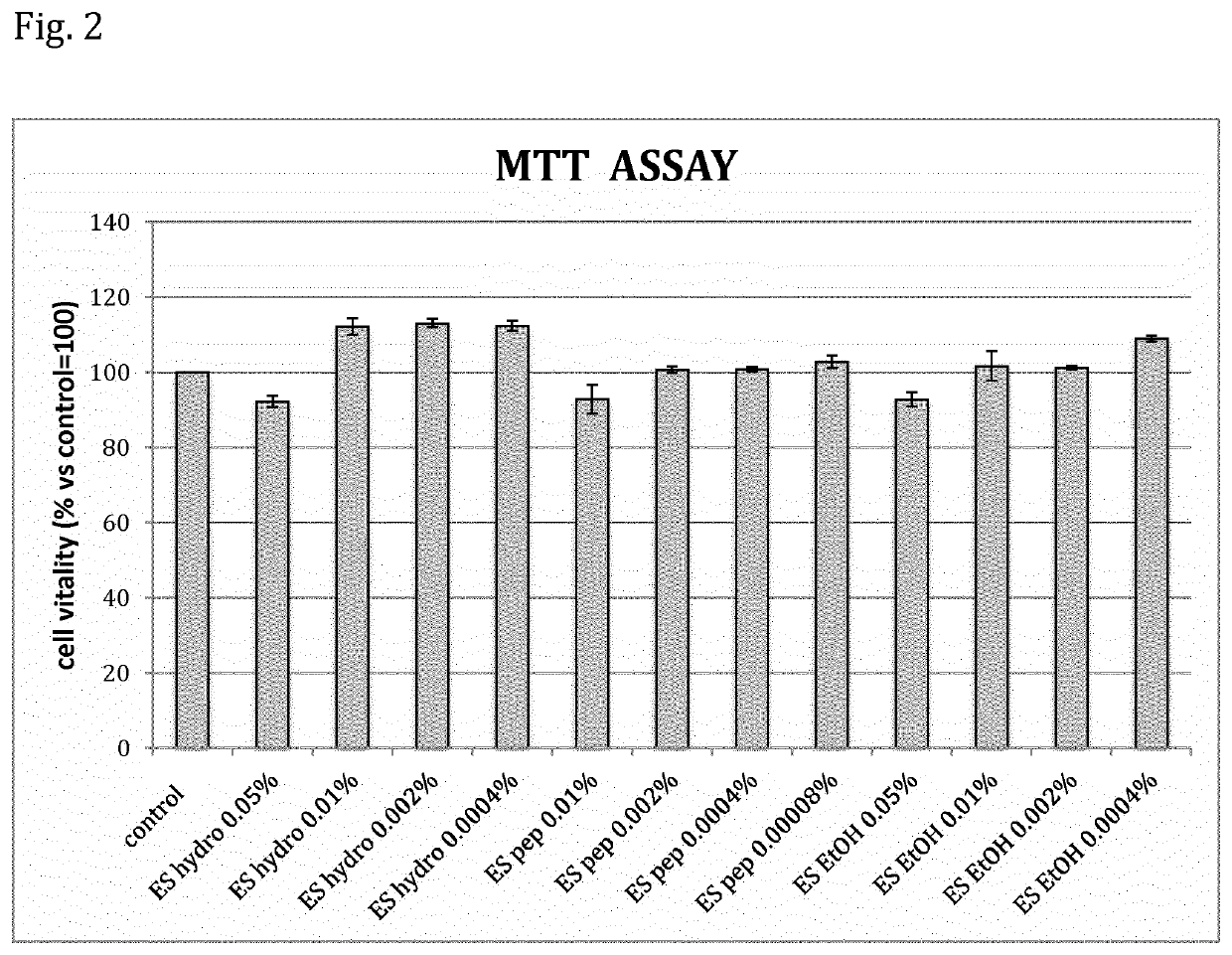Cosmetic use of extracts derived from somatic embryo enriched plant cell cultures and cosmetic compositions containing those extracts
a technology of plant cell culture and cosmetic composition, which is applied in the direction of plant/algae/fungi/lichens, horticulture, plant cell ingredients, etc., to achieve the effect of slowing down and reversing the phenomenon of skin cell aging
- Summary
- Abstract
- Description
- Claims
- Application Information
AI Technical Summary
Benefits of technology
Problems solved by technology
Method used
Image
Examples
example 1
Preparation and Growth of Lotus japonicus, Citrus lemon and Rosa gardenia (Var. Maipaleo) Somatic Embryo Cell Cultures
[0063]Pieces of young leaves of Lotus japonicus, Citrus lemon and Rosa gardenia were used for callus formation on solid medium, and subsequently liquid cell cultures were induced to form somatic embryos. The observation of samples of non-induced cell cultures and cell cultures induced to form somatic embryos, made it evident that, after 4 weeks of growth, cells in the induced culture were differentiated and aggregated to form embryo-like structures, which made the culture more grainy compared to that of non-induced cells (FIG. 1). Once dense cultures of somatic embryos from the 3 different species were obtained, the percentage of differentiation after 4 weeks was evaluated by observation on optical microscope, and staining with methylene blue in 0.01% aqueous solution. For Lotus japonicus cell culture a yield of differentiation of 90% was calculated, 80% for Citrus l...
example 2
Preparation of Different Extracts from Somatic Embryo Cell Cultures of the Species Lotus japonicus, Citrus lemon and Rosa gardenia
[0065]The harvested somatic embryos were processed in order to obtain extracts with different chemical characteristics. 3 types of extracts from somatic embryo cell cultures belonging to the species Lotus japonicus, Citrus lemon and Rosa gardenia were obtained. For each of the species the following extracts were prepared: a) an extract of water-soluble compounds (hydrosoluble extract), obtained by the use of a water-based saline buffer (PBS); b) an extract of lipophilic compounds which is able to dissolve in non-polar or poorly polar solvents, obtained by using ethanol; c) an extract composed of peptides and sugars derived from the cell walls, obtained by the already described procedure. The obtained extracts were treated in order to eliminate the solvent (water or ethanol in the specific case) by lyophilization or vacuum evaporation. The obtained powder...
example 3
Biological Assays of Somatic Embryo Cell Cultures Derived Extracts on Skin Cells
[0070]As an illustrative and non-limiting example of the present invention, Lotus japonicus somatic embryo extracts have been used to elucidate the beneficial and therapeutic properties on skin cells. The hydrosoluble extract, the liposoluble one (ethanolic) and the one composed of peptides and sugars, deriving from the cell walls, were tested on HDF cells (Human Dermal Fibroblasts) in order to evaluate the cosmetic activity. The methods used in the assays and the obtained results are described hereinafter.
Methods Used:
[0071]This assay is based on the use of MTT [3-(4,5-dimethylthiazol-2-yl)-2,5-diphenyltetrazolium bromide] for the first time described by Mosmann in 1983. It is based on the capacity of the enzyme mitochondrial dehydrogenase of the viable cells to hydrolyze the MTT tetrazolium ring (light yellow) and to form crystals of formazan (dark blue color). These crystals are imp...
PUM
| Property | Measurement | Unit |
|---|---|---|
| pH | aaaaa | aaaaa |
| weight | aaaaa | aaaaa |
| diameter | aaaaa | aaaaa |
Abstract
Description
Claims
Application Information
 Login to View More
Login to View More - R&D
- Intellectual Property
- Life Sciences
- Materials
- Tech Scout
- Unparalleled Data Quality
- Higher Quality Content
- 60% Fewer Hallucinations
Browse by: Latest US Patents, China's latest patents, Technical Efficacy Thesaurus, Application Domain, Technology Topic, Popular Technical Reports.
© 2025 PatSnap. All rights reserved.Legal|Privacy policy|Modern Slavery Act Transparency Statement|Sitemap|About US| Contact US: help@patsnap.com



